As an Enviroschools early childhood centre, we are on an ongoing learning journey. We engage with Enviroschools partners (Toimata Foundation, Enviroschool facilitators, Auckland Council, Auckland Kindergarten Support Services) together with the local school, colleagues, whānau and tamariki to grow our practice. We have been on an action journey since last year when we started this project of creating an Exploration Garden where ngā tamariki can have authentic hands-on experiences. It is a shared space of mara kai for us and our fauna.
Engagement
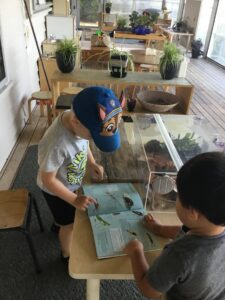
Tamariki check out the local fauna and use books for identification.
The inspiration for the Exploration Garden was given impetus through engaging in the National Environment Targeted Rate (NETR) project. The focus for the fund was creating an awareness of our existing biodiversity and enhancing it. This prompted us to find out what was already in our centre environment and then think about what would help create a vibrant learning living landscape.
Ngā tamariki were encouraged to observe and are now becoming more aware of the local plants, manu (birds) and the bugs that share our space. They can identify some of the native plants and have developed a love for herbal tea while exploring the properties of the kawakawa plant. This was our way of exploring the rongoā, medicinal properties of some native trees. Children began sharing stories of their cultural herbal drinks and has inspired us to investigate an option of a tea garden in the Exploration Garden. It will offer us a sensory experience too.
“On the Enviroschools Green-Gold sharing day Rangatira, James, was so busy looking after the special guests “showing them everything, everywhere, all over and reminded them to “sssh!” as the worms were sleeping. He was so busy working that he did not even have time to share in the kawakawa tea and was so disappointed! So, promises were made that more kawakawa tea could be made the next day. He was happy – and promptly fell asleep!” – Shared by Sangeeta.
Mahi tahi
Mahi tahi gets the work done! It is a value held close by us. We worked in partnership with our whānau as the Exploration Garden project began last year. Over time we gradually emptied our previous infant and toddler sandpit. Yes, the aim was to revamp and create a new landscape. The addition of the water tank in this space is teaching us all about conserving and using water wisely. Previously, we had added 6 native plants through the Paper for Trees recycling programme, and we saw the possibility to do more. The vision is to have enough nectar and food year-round for our birds and pollinators. We did some research to investigate which plants will thrive in Tāmaki Makaurau. We consulted with tangata whenua and used the Auckland Council website.
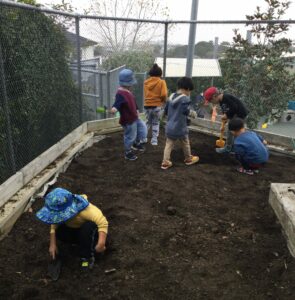
Tamariki developed the initiative to find big lumps of soil and break them up.
Our additional learning was that trees carry stories, and each tree has its own whakapapa. We learnt that according to maramataka, the Māori calendar, planting of rākau is best during winter months. This learning ensured that we planned accordingly. Our newly created native garden space will carry its own story.
Trees are life, and what better way to connect children to cherish this timeless treasure than actively involving them in the project. The fruit trees that we planted almost 3 years ago have begun their fruiting cycle. The plants are looking more established too. Tamariki enjoy the process of harvesting fruit from the mara kai as they carry the fresh produce in the kai kete to the Centre Cook.
Daily practices
Through storytelling, daily conversations, active involvement in the project and hands on experiences tamariki are able to relate to the value and place of trees in the past, in today’s time and in the future. The commonly revisited stories are, “Rata and the Waka” and “The Gift of Mamaku”.
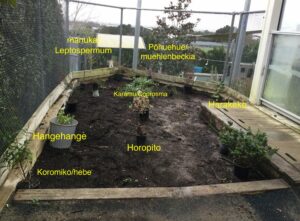
The plant placement plant for the garden prior to planting up.
The native garden nestled in a corner of the Exploration Garden overlooking the main playground is a taonga for us all. This project has given us this sense of belonging to our place as we have contributed to it in some way. It has strengthened our sense of tūrangawaewae, as we leave a mark behind through this rākau/ tree planting project. We are anticipating that our Centre will be a haven for local flora and fauna with time. This environment will be a living landscape for integrating the teaching and learning of local biodiversity through the daily curriculum.
Massive planting effort creates legacy
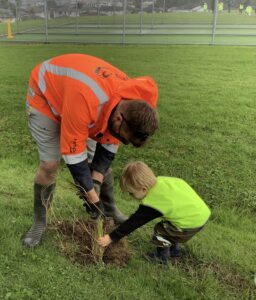
Doing the mahi together.
While venturing in this centre-based project of adding rākau to our space, we got this amazing opportunity to join hands with Mission Heights Schools Legacy project and participate in their massive planting of 19,000 trees. We joined them on the community tree planting day and had massive participation from the teachers and whanau from KiNZ Mission Heights. We were allocated 3 time slots during the weeklong planting programme. Parents supported us in this planned excursion and the school children thrived on having opportunity to work with our young learners. The tuākana- tēina relations and the opportunity to ako was very evident.
Kaitiakitanga
This project enabled us to put kaitiakitanga practices into action as we have this ongoing commitment to waste minimisation. We researched and worked on troubleshooting issues with our worm farms. Tamariki enjoy getting noke kai ready by cutting them in small pieces as a communal experience. We added more planter boxes for mara kai as part of the project and used the nourishing fertiliser from the worm farm and centre compost. The annual waste audits are verifying our ongoing focus of reduction of landfill rubbish.
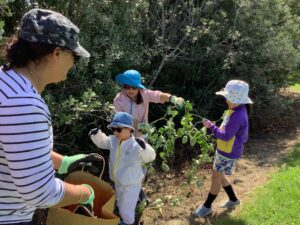
Working to remove moth plants.
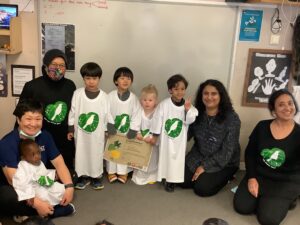
Acknowledgement from Pest Free Howick.
This year, as we participated in the moth pod competition. This community experience has brought us closer to rākau. It helped us to better understand our roles as guardians to nature. We saw the impacts of pest plants on the native trees. Children felt empowered that they could rescue the native trees from these invasive pests. The bonus was that we got acknowledged for our efforts by receiving the first prize as we removed 5122 moth pods and vines in our local area.

It takes a whole team.
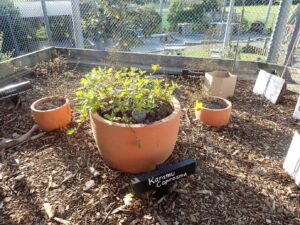
The plants planted and potted up in place.
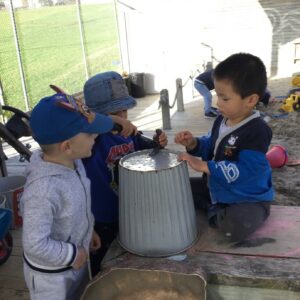
Children worked as a team to upcycling these metal bins that was given to us by a family as planters pots.
Pest Free Howick presented this opportunity – “Native trees for Manu”. It as an opportunity to add to our aim to creating habitats for our native fauna. Imagine having your own ngahere where children can explore and use as a classroom in the future – the giant mamaku/pongo nestled in the midst so we can share the local pūrākau of our place with tamariki. The occasional visits by native birds, tūī and kererū has being inspirational too. This vision empowered me to negotiate with the local school for some space as I anticipated the project to go on the outside of the back fence line.
To start the project, as we waited for native seedlings from Pest Free Howick, we decided to plant the ones we were gifted for participating in the Moth Pod Competition. This planting was aligned with all the rākau planting done in June, marking Matariki too. A parent blessed this special occasion for us. We pledge to nurture this space for years to come. We are hopeful that, with time, more native animals will be attracted to this space, bringing back some ecological stability in our urbanised setting.
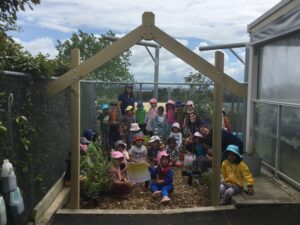
Feeling proud. Affirming their Enviroschools Green-Gold status in the newly established part of the Exploration Garden.
Bold gold
These are some big, bold steps that we have taken as we make sense of the importance of trees in our settings affirm our Green-Gold Enviroschool status. To celebrate all the mahi that will be going towards the Exploration Garden, we are planning to have a celebration day for with our whānau and special guests. We, the teachers and children, will share our new landscape as we reflect on the past and look forward to our future.
“I am basking in the after-glow of seeing beautiful child-led learning, of committed, empowered communities, and of courageous leadership where tamariki are flourishing when we visited KiNZ mission Heights for the Green-Gold sharing day” – Debbie Upham, Education for Sustainability Specialist, Ngā Tamariki Puāwai o Tāmaki/ AUCKLAND KINDERGARTEN ASSOCIATION
